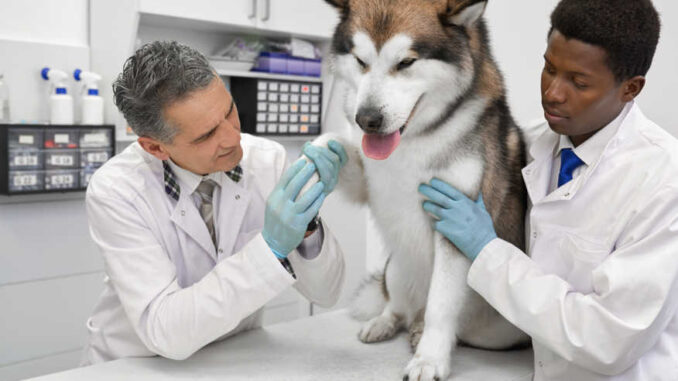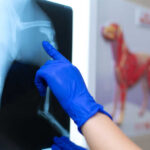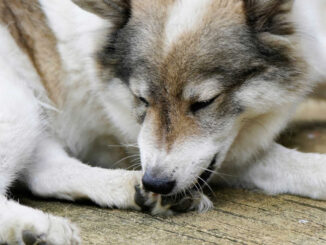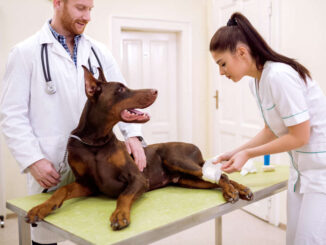
This article was updated on June 6th, 2023
Just like in people, limping is a common issue in dogs. While limping can be due to a variety of conditions, this abnormal gait is either caused by pain or loss of function. The difference is that dogs can’t use words to tell us where it hurts, and it can often be difficult to tell when a dog is experiencing minor pain. Your dog may just to start to limp or try to avoid putting weight on a leg. Let’s examine some of the most common causes of limping, what you can do at home, and when to contact your vet.
My dog limps or won’t put weight on a leg, but does not seem to be in pain. What’s wrong?
If your dog is limping or won’t put weight on a leg, they are most likely doing so as a result of some pain. Limping can also be caused by:
- a very minor reason such as something is stuck in their foot
- an injury or strain that is causing discomfort (but not severe pain)
- conditions such as arthritis, hip dysplasia, or ligament or muscle injuries
- neurological issues or loss of function of the limbs.
If a limp is not resolving, is severe, or is accompanied by other concerning clinical signs, it is important to seek veterinary care. To help determine the cause of the limp and next steps, it can be helpful to consider these things:
- Severity of the limp – Is your dog still putting some weight on the affected leg, or are they holding it up? Do they put weight on it when they stand? Is the limp constant or does it come and go?
- How long have they been limping? – A sudden injury, such as a torn cranial cruciate ligament will cause an acute (sudden) onset of limping. Chronic (long-term) or intermittent limping is more likely to be due to something like arthritis.
- Is there an obvious injury? – If your dog tolerates it, you can examine their limbs and paws to look for any evidence of injury, bleeding, foreign object, or swelling.
- Are there other clinical signs? – Some conditions that cause limping (such as Lyme disease) will also cause other clinical signs. Additionally, if a dog is in severe pain, you will likely notice changes in their behavior.
Watch this video of a veterinarian checking on a dog’s limp which is caused by a muscle strain:
Top reasons causing dogs to limp (without other visible signs of pain)

Dogs may limp without other visible signs of pain due to a variety of reasons. In these cases, your dog will still be eating, drinking, urinating, and defecating normally, and have a normal energy level. We have listed below the most frequent reasons. You can also read our articles about causes specific to back leg limping and front leg limping in dogs. Let’s take a look:
1. Foreign object
Dogs can sometimes limp or show signs of discomfort when they have a foreign object stuck in their paw, such as a splinter, rock, thorn, plant material, or piece of glass. Foreign objects can cause pain and irritation, making it difficult for them to walk normally. Other types of paw injuries that can lead to limping include torn toenails, insect bites or stings, pododermatitis (skin infection between the paw pads), and other minor cuts or scrapes. Examine your dog’s paw and leg carefully. Look for any signs of swelling, redness, or cuts, and gently feel around the paw and leg to see if you can feel any foreign objects in the hair or skin.
2. Soft tissue injury or muscle strain
Strains or sprains in dogs can happen when a muscle, tendon, or ligament is stretched beyond its normal limits or is torn. This can be caused by overexertion, sudden movements, or falls. Pain, heat, and swelling may be noticeable on exam depending on the severity.
Common symptoms include:
- Limping – may be acute, chronic, or intermittent
- Stiffness and decreased range of motion in the affected leg
- Swelling and pain in the affected area
- Reluctance to move or play
- Whimpering or crying when touched
Mild soft tissue injuries may resolve with at-home care including strict rest. If the limp is not imporoving, appears severe, or you notice other concerning clinical signs, a veterinary visit is in order for diagnostics and treatment with pain medications and anti-inflammatories.
3. Arthritis (degenerative joint disease)
Joint disease is a common condition in dogs, especially as they reach their senior years (6-8 years old). The most common type of joint disease in dogs is osteoarthritis, which is a degenerative condition that affects the cartilage and bone in the joints.
Common symptoms include:
- Limping that is chronic or intermittent – may be worse after exercise or in the morning
- Stiffness and decreased range of motion in affected limbs
- Difficulty getting up after resting
- Difficulty jumping up on furniture and on stairs
- Licking the affected joint
Arthritis can be diagnosed based on physical exam and x-rays. While arthritis is a progressive condition and has no cure, it can often be successfully managed with a multimodal approach including joint supplements such as glucosamine, chondroitin, and omega 3 fish oil, prescription pain medications and anti-inflammatories, injectable medications, physical therapy, and alternative treatments such as acupuncture Keeping your dog at an ideal body condition score will also help reduce pressure and stress on their bones and joints.
The dosage of these supplements is based on your dog’s weight. Please discuss recommendations with your veterinarian before starting your dog on any sort of supplement or medication.
- Joint Health Support for Dogs: Cosequin, the veterinarian recommended retail joint health supplement brand, contains glucosamine hydrochloride, sodium chondroitin sulfate, and methylsulfonylmethane (MSM) that helps support healthy cartilage
- Joint Health Support for Dogs: Dasuquin, the #1 veterinarian recommended joint health supplement brand▼, combines the synergistic benefits of avocado/soybean unsaponifiables (ASU), glucosamine and chondroitin sulfate to help support healthy joints. For dogs under 60 lbs.
- WHY OMEGA-3 PET - This Nordic Naturals pet product is made with the same exceptional quality oil as our human products, but has been specially formulated for your dog. Omega-3 Pet features omega-3 fish oil in soft gels.
4. Hip or elbow dysplasia
Hip and elbow dysplasia are genetic conditions that affect the development and function of the hip and elbow joints in dogs. Both hip and elbow dysplasia can cause lamenessand reduced mobility. Hip dysplasia and elbow dysplasia aremost common in large and giant dog breeds, including German Shepherds, Retrievers, and Great Danes. Some dogs are affected during puppyhood, while others do not develop symptoms until later in life.
Common symptoms include
- Chronic intermittent lameness that never fully resolves
- Unwillingness to walk if both limbs are affected
- Dogs with hip dyspalsia may show a typical bunny hopping gait, may be reluctant to rise, and have difficulty on stairs
These conditions are diagnosed with x-rays under sedation or anesthesia. The treatment for hip and elbow dysplasia in dogs depends on the severity of the condition and the age and activity level of your dog. In mild cases, conservative management with medications may be sufficient to manage the symptoms.. This may include weight management, exercise modification, joint supplements, physical therapy, pain medication, and anti-inflammatories.In more severe cases, surgery may be necessary to manage the condition and prevent further joint damage.
5. Luxating patella
Luxating patella is a condition in which the kneecap dislocates or moves out of place. It is most common in small breed dogs, and can range in severity from a kneecap that can be moved out of place with pressure (grade 1) to a kneecap that is always out of place (grade 4).
Common symptoms include:
- Intermittent limping or hopping
- Visible kneecap displacement
Higher grade luxating patella may cause long-term issues for your pup. Treatments include surgery or medical management with anti-inflammatory drugs. 6. Cruciate ligament injury:
A cranial cruciate ligament injury is a tear or rupture of the ligament that stabilizes the knee joint. This injury usually occurs as a result of a sudden turning or twisting motion.
Symptoms include:
- Limping
- Swelling of the knee joint
- If the ligament is partially torn your dog may have a mild or intermittent limp, however if the ligament is completely torn they will not be able to bear any weight on the affected leg.
Your vet will diagnose this type of injury based on physical exam (including the presence of a cranial drawer sign) and x-rays. Surgery is the recommended treatment for most dogs, however, if this is not possible, strict rest and medical management may be attempted. Your vet will discuss treatment options, the multiple types of surgery available, and referral to an orthopedic specialist.
7. Neurological issue
If your dog has a neurological issue (such as intervertebral disc disease or degenerative myelopathy) causing weakness or lack of function in one or more limbs, it can also cause limping. If your vet suspects a neurological issue, they may recommend referral to a neurologist.
Symptoms will vary based on the underlying cause but may include:
- Abnormal gait or limp
- Loss of proprioception or knuckling under of the paw
- Loss of pain
- Weakness or ataxia (wobbly gait)
8. Other causes of limping
While the causes of limping above will cause discomfort for your dog, you may not notice additional signs of pain or disease. The causes of limping below may cause additional clinical signs and require immediate veterinary attention.
- Bone cancer
- Infectious disease such as Lyme
- Immune mediated disease such as immune-mediated polyarthritis
- Severe trauma such as hit by car
- Fracture
How to tell if your dog is in pain
Dogs have a natural instinct to hide their pain and discomfort, as this is a survival mechanism in the wild. Since dogs are known to be good at hiding pain, it can sometimes be challenging to recognize when they are experiencing discomfort. It is important to note that even if you do not notice these clinical signs, a limp in itself most likely indicates that your dog is in pain.
- Changes in behavior: Dogs in pain may become more withdrawn or irritable, and may not want to play or engage in activities they normally enjoy.
- Vocalization: Dogs may whine, whimper, or yelp in pain, especially when touched or moved.
- Changes in posture: Dogs may adopt a hunched or tense posture, or they may keep their head down.
- Loss of appetite: Dogs in pain may lose their appetite or show disinterest in their food.
- Changes in sleep patterns: Dogs in pain may sleep more or less than usual, or they may be restless and have trouble sleeping comfortably.
- Excessive licking or chewing: Dogs may excessively lick or chew an area that is painful or uncomfortable.
- Changes in breathing: Dogs may pant or breathe rapidly when they are in pain.
First-aid for a dog who suddenly starts to limp (but acts normal)
If your dog suddenly starts to limp, there are a few first-aid measures you can take to help them and prevent further injury, while waiting for your veterinary appointment. Here are some steps you can take:
1. Examine the area – Look for any sign of injury, foreign body, infection, swelling, and pain in the affected limb.
2. Rest the limb: Minor soft tissue injuries may resolve with a couple days of strict rest. This means no running, jumping, or playing for your pup. Take them out on a leash to go potty and keep them confined when unsupervised.
3. Apply a cold compress: Applying a cold compress to the affected area can help to reduce swelling and pain. You can use a bag of frozen vegetables or an ice pack wrapped in a cloth. Apply the compress for approximately 5 minutes at a time, several times per day.
3. Observe your dog’s behavior: Watch your dog for any changes in behavior or mobility. If they are unable to put any weight on the affected limb or if the limping persists for more than a day or two, you should seek veterinary attention.
It’s important to remember that first-aid measures are not a substitute for veterinary care. If your dog’s limp is severe or does not improve with first-aid measures, you should seek prompt veterinary help to ensure correct diagnosis and treatment.
When to call your veterinarian
If your dog is limping but not in obvious pain, it’s still important to monitor their condition closely. If the limping persists for more than a day or two, or if you notice any other changes in your dog’s behavior or mobility, you should contact your veterinarian: limping can be a sign of a variety of health issues, some of which may not be immediately obvious or painful for your dog but that do require veterinary treatment.
If you notice the following signs in a limping dog, see your vet as soon as possible or head to an emergency animal clinic:
- A broken or dangling limb
- An injury that is bleeding significantly
- Other signs of illness in conjunction with the limp such as loss of appetite, lethargy, fever, vomiting, or diarrhea.
Diagnosing your dog’s limp: what will happen at the vet
To diagnose the cause of a dog’s limp, your veterinarian will typically perform a physical examination and may also recommend additional diagnostic tests depending on the suspected cause of the limp. Here are some steps a veterinarian may take to diagnose a dog’s limp:
1. Physical examination: The vet will watch your dog walk. They will visually examine the affected limb and look for any signs of swelling, bruising, or deformity. They will also palpate the area to check for pain, sensitivity, and range of motion. They may also perform an orthopedic exam, which is a more detailed exam of your pet’s musculoskeletal system including their bones, joints, and muscles.
2. Diagnostic imaging: The vet may recommend X-rays, ultrasound, or other diagnostic imaging tests to get a closer look at the affected limb and identify any underlying issues that may be causing the limp. X-rays are generally a great way to identify bony injury, such as arthritis or fractures. Soft tissue injuries may not be visible on x-rays, but they will likely still be recommended to rule out other more serious causes of limping.
3. Other diagnostics tests: In some cases, your veterinarian may recommend blood tests to check for underlying health conditions causing your dog’s limp. These tests may also be recommended if your veterinarian plans to put your dog on certain medications for their limp. Find out about the costs of blood tests in dogs.
4. Treatment: Treatment will depend on the underlying cause of the limp. It may involve medications, at home care such as strict rest, surgery, or a combination of all of the above.
FAQ
Can I give my dog Aspirin or pain medication to help with the limp?
Do not give your dog any human or over-the-counter medications. Some of these medications can be extremely dangerous for pets. If your dog’s mild limp is not improving or if the limp is severe, see your veterinarian. They will be able to prescribe medication that is both safe and effective to help your furry family member feel better soon.
Additionally, limping can be caused by a variety of health issues, some of which may require specific treatments. Therefore, it is important to have your dog evaluated by a veterinarian to determine the underlying cause of the limp.
Related posts about dogs limping:
 Dog Limping & Licking Their Paws: Our Vet Explains - Pet parents often encounter a variety of health issues with their dogs, and among them, paw licking and limping are… [...]
Dog Limping & Licking Their Paws: Our Vet Explains - Pet parents often encounter a variety of health issues with their dogs, and among them, paw licking and limping are… [...] Dog Limping & Shaking: What Could Be Going On With Your Dog? - Pet parents often encounter a variety of health issues with their dogs, and among them, limping and shaking are common.… [...]
Dog Limping & Shaking: What Could Be Going On With Your Dog? - Pet parents often encounter a variety of health issues with their dogs, and among them, limping and shaking are common.… [...] Back Leg Limping in Dogs: Our Vet Explains What to Do - In our clinic, I see dogs limping on a daily basis; it's an all-too-common problem. Many people assume the worst,… [...]
Back Leg Limping in Dogs: Our Vet Explains What to Do - In our clinic, I see dogs limping on a daily basis; it's an all-too-common problem. Many people assume the worst,… [...]Disclaimer: This website's content is not a substitute for veterinary care. Always consult with your veterinarian for healthcare decisions. Read More.








Be the first to comment